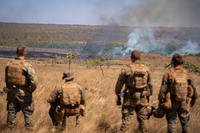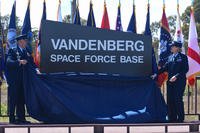RAMSTEIN AIR BASE, Germany -- Six countries provided more than 150 paratroopers to participate in International Jump Week hosted by the 435th Contingency Response Group from Aug. 12 - 17 near Ramstein.
The paratroopers came from the Czech Republic, Germany, Italy, the Netherlands, Spain, and the U.S. Air Force and Army and jumped from two C-130J Super Hercules aircraft and one C-17 Globemaster III provided from the Heavy Airlift Wing from Papa Air Base, Hungary.
"International Jump Week is an opportunity for U.S. and partner forces to get together for five or six days here," said Col. Mark Visconi, 435th Contingency Response Group commander. "We practiced jumps into Alzey, Germany, to trade tactics, techniques and procedures as well as build partnerships between multiple forces."
The 435th CRG hosts the event, with help from members of various Air Force and Army units in the area.
"The contingency response group hosts this event, but we have members from all across the 435th Air Ground Operations Wing. There is a significant amount of planning between aircrews, and personnel," Visconi Said. "The 37th Airlift Squadron and the Heavy Airlift Wing brought the aircraft here. There's also coordination with our friends here at Rhine Ordinance Barracks with the 5th Quartermaster Company, 21st Theater Sustainment Command."
The daily jumps wouldn't have been possible without the riggers from the 5th Quartermaster Company. packing the parachutes used, coordinating with the Air Force and hosting the training before jumps, said Staff Sgt. Tyler Buckingham, the NCO in charge of air operations. That partnership was key to a successful event.
"Our procedures within the aircraft are different, but all static-line parachutes are mostly the same," Buckingham said. "You just jump out and count to four."
Training was conducted Sunday, Aug. 12, for the week's jumps at Rhine Ordinance Barracks.
"We began training Sunday, doing some basic intro briefs, parachute training and training with our various jumpmasters in a model C-130," Visconi said. "We went over basics to ensure familiarity because each nation represented here speaks a different language and we wanted to make sure we're all on the same page."
Training with the German jumpmasters breaks the monotony out of the usual jumping, said Sgt. Johnny Connish, an Army parachute rigger.
"Anytime we get the chance to get together and get different training, this is a good time," Connish said.
The training and preparation work beforehand lead to successful jumps throughout the week.
"This is my first jump in Germany, I've been here about three weeks," said Senior Airman Christopher Zavala, 435th Security Forces Squadron combat tactics NCO. "It was great, I couldn't have asksed for better weather, the sun is out and there were no winds and I landed softly on the drop zone. Everything came together perfectly."
Cpl. Benjamin Wilkinson, an air operations noncommissioned officer with the 5th Quartermaster Detachment said camaraderie with foreign forces is important to him."You have people from all over the world, jumping out of airplanes," said Wilkinson, a native of Purdue, Mo. "It's a good chance to work with everybody and see how they do their jobs.
Both NATO leaders and Visconi agreed that building partnerships through this week-long event will probably be the most important thing taken from International Jump Week.
"We have a very good camaraderie; it's very good how we all came together to jump here this week," said Major Tim Holzaptel, Airborne Brigade 373rd deputy commander. "For me and my battalion it's a great experience to build up partnerships, share techniques and just get to know our counterparts better."
"Going beyond learning the various techniques and procedures each country carries out in the aircraft before jumps, the biggest thing we'll learn throughout the week is how we build partnerships between our various forces," Visconi said. "That relationship building will be the biggest piece that we all pull away from International Jump Week."


























